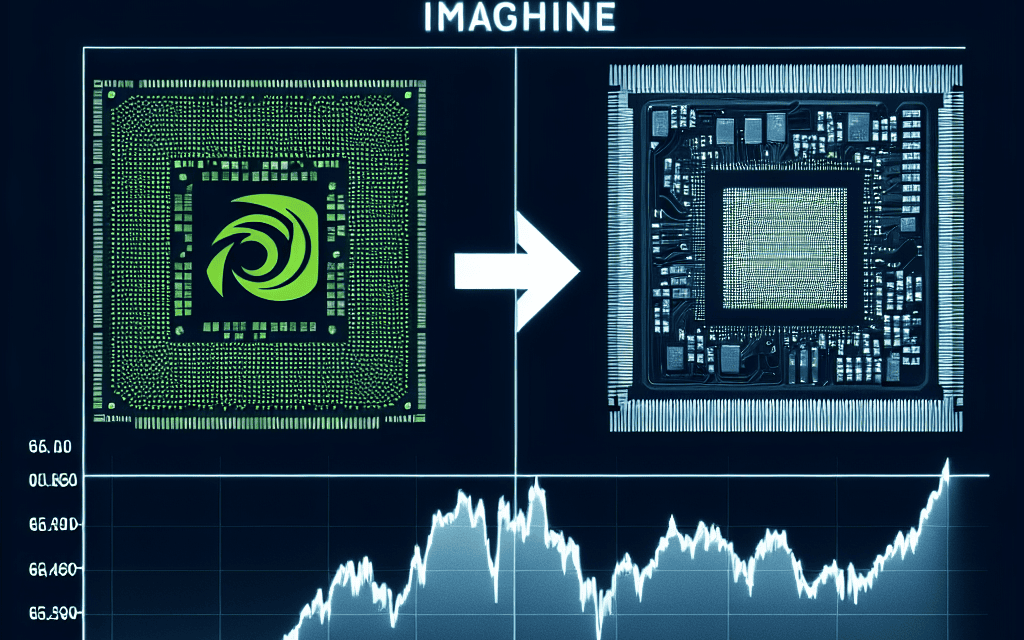“Powering the Future: Nvidia Takes the Helm in the Dow Jones Industrial Average.”
Introduction
Nvidia, a leading technology company renowned for its advancements in graphics processing units (GPUs) and artificial intelligence (AI), is poised to replace Intel in the Dow Jones Industrial Average (DJIA), marking a significant shift in the landscape of the stock market’s most prestigious index. This change reflects the evolving dynamics of the technology sector, where Nvidia’s innovative contributions to AI, gaming, and data centers have propelled it to the forefront of the industry. As Nvidia steps into this prominent position, it underscores the growing importance of AI and high-performance computing in the global economy, while also highlighting the challenges faced by traditional semiconductor giants like Intel in adapting to rapidly changing technological demands. This transition in the DJIA not only signifies Nvidia’s rising influence but also signals a broader transformation within the tech industry, as companies that drive innovation in AI and computing power become increasingly central to economic growth and market performance.
Impact Of Nvidia’s Inclusion On The Dow Jones Industrial Average
Nvidia’s anticipated inclusion in the Dow Jones Industrial Average marks a significant shift in the landscape of the stock market, reflecting broader changes in the technology sector and the economy at large. As Nvidia prepares to replace Intel, this transition underscores the evolving dynamics within the semiconductor industry and highlights the growing importance of artificial intelligence and graphics processing technologies. The Dow Jones Industrial Average, a key barometer of the U.S. stock market, is designed to represent the broader economy by including 30 prominent companies from various sectors. The decision to include Nvidia, a leader in graphics processing units (GPUs) and AI technology, signifies a recognition of the company’s substantial impact on the tech industry and its potential for future growth.
The inclusion of Nvidia in the Dow Jones is expected to have several implications. Firstly, it reflects the increasing relevance of AI and machine learning technologies in today’s economy. Nvidia’s GPUs are not only pivotal in gaming but also play a crucial role in data centers, autonomous vehicles, and other AI-driven applications. This shift in focus from traditional semiconductor applications to more advanced computing solutions highlights the changing priorities within the tech sector. As Nvidia takes its place in the Dow, it brings with it a narrative of innovation and forward-thinking, which could influence investor sentiment and attract more attention to companies involved in cutting-edge technologies.
Moreover, Nvidia’s inclusion may lead to increased volatility in the Dow Jones Industrial Average. Given Nvidia’s history of rapid growth and its involvement in high-demand sectors, its stock price tends to be more volatile compared to some of the more established companies in the index. This could introduce new dynamics to the Dow, potentially affecting its overall performance and the way investors perceive it. However, this volatility also presents opportunities for investors seeking growth, as Nvidia’s strong market position and continuous innovation could drive significant returns.
In addition to these market dynamics, Nvidia’s entry into the Dow Jones also highlights the competitive pressures faced by traditional semiconductor companies like Intel. Intel’s replacement by Nvidia signals a shift in market leadership, emphasizing the need for established companies to adapt to the rapidly changing technological landscape. This transition serves as a reminder of the importance of innovation and agility in maintaining a competitive edge in the tech industry. As Nvidia continues to push the boundaries of what is possible with its technologies, other companies may be inspired to accelerate their own innovation efforts to keep pace.
Furthermore, Nvidia’s inclusion in the Dow Jones could have broader implications for the index’s composition and its representation of the U.S. economy. As the tech sector continues to grow in importance, the Dow may increasingly reflect the dominance of technology companies, potentially leading to further adjustments in its composition. This shift could prompt discussions about the criteria for inclusion in the index and how best to represent the evolving economic landscape.
In conclusion, Nvidia’s anticipated inclusion in the Dow Jones Industrial Average is a testament to the company’s influence and the transformative power of technology in today’s economy. As Nvidia replaces Intel, it brings with it a narrative of innovation and growth, while also introducing new dynamics to the index. This transition not only highlights the changing priorities within the tech sector but also underscores the importance of adaptability and forward-thinking in maintaining a competitive edge. As the Dow continues to evolve, Nvidia’s presence will undoubtedly shape its future trajectory and the broader perception of the U.S. stock market.
Historical Context: Tech Companies In The Dow Jones
The Dow Jones Industrial Average (DJIA), a stock market index that has been a barometer of the American economy since its inception in 1896, has long been a reflection of the industrial and economic shifts within the United States. Initially dominated by companies in sectors such as railroads, cotton, and gas, the index has evolved to include a diverse array of industries, mirroring the changing landscape of the American economy. Over the years, technology companies have increasingly become a significant part of this index, reflecting the growing importance of the tech sector in the global economy. The inclusion of tech giants like Apple, Microsoft, and IBM has underscored the pivotal role technology plays in driving economic growth and innovation.
Historically, the inclusion of technology companies in the DJIA has been a gradual process. IBM was the first tech company to be added to the index in 1979, marking a significant shift in the composition of the DJIA. This inclusion signaled the beginning of a new era where technology would become a cornerstone of economic development. Over the subsequent decades, other tech companies followed suit, with Microsoft and Intel joining the index in 1999, further cementing the tech sector’s influence. These additions were not merely symbolic; they represented the tangible impact of technological advancements on productivity, efficiency, and global connectivity.
As the tech industry continued to expand, the DJIA underwent further transformations to better represent the modern economy. The removal of companies from traditional industries and the addition of tech firms highlighted the dynamic nature of the index. For instance, in 2013, the DJIA saw the inclusion of Apple, a company that revolutionized consumer technology with its innovative products. This move was indicative of the broader trend of digitalization and the increasing reliance on technology in everyday life.
In recent years, Nvidia, a leader in graphics processing units (GPUs) and artificial intelligence (AI), has emerged as a formidable force in the tech industry. The company’s innovations have not only transformed gaming and entertainment but have also had profound implications for fields such as data science, machine learning, and autonomous vehicles. Nvidia’s potential inclusion in the DJIA, replacing Intel, marks another significant milestone in the index’s history. This change reflects the ongoing evolution of the tech landscape, where AI and machine learning are becoming integral to various sectors, from healthcare to finance.
The potential replacement of Intel by Nvidia in the DJIA underscores the shifting priorities within the tech industry. While Intel has been a stalwart in the semiconductor industry, Nvidia’s focus on AI and high-performance computing aligns with the current trajectory of technological advancement. This transition highlights the importance of adaptability and innovation in maintaining relevance in a rapidly changing market.
In conclusion, the historical context of tech companies in the Dow Jones Industrial Average illustrates the broader economic and industrial shifts that have occurred over the past century. The potential inclusion of Nvidia in the index is a testament to the transformative power of technology and its ability to redefine industries. As the DJIA continues to evolve, it will undoubtedly reflect the ongoing changes in the global economy, with technology at the forefront of this transformation. This evolution not only highlights the significance of tech companies in shaping the future but also underscores the dynamic nature of the American economy.
Nvidia’s Growth Trajectory And Market Influence
Nvidia’s remarkable ascent in the technology sector has positioned it as a formidable contender to replace Intel in the Dow Jones Industrial Average, a shift that underscores the evolving landscape of the semiconductor industry. This potential change reflects Nvidia’s impressive growth trajectory and its increasing influence in the market, driven by its strategic focus on cutting-edge technologies such as artificial intelligence, gaming, and data centers. As the demand for high-performance computing solutions continues to surge, Nvidia’s innovative approach and robust product offerings have enabled it to capture significant market share, challenging established players like Intel.
In recent years, Nvidia has consistently demonstrated its ability to adapt to the rapidly changing technological environment. The company’s strategic investments in research and development have resulted in groundbreaking advancements in graphics processing units (GPUs), which have become essential components in a wide range of applications beyond traditional gaming. For instance, Nvidia’s GPUs are now integral to the development of AI models, powering machine learning algorithms that require immense computational power. This diversification has not only expanded Nvidia’s market reach but also solidified its reputation as a leader in the semiconductor industry.
Moreover, Nvidia’s financial performance has been nothing short of impressive. The company’s revenue growth has consistently outpaced that of its competitors, driven by strong demand across its various business segments. This financial success has been reflected in its stock performance, with Nvidia’s market capitalization surpassing that of Intel, a testament to investor confidence in its long-term prospects. As a result, Nvidia’s inclusion in the Dow Jones Industrial Average would not only reflect its market dominance but also align the index with the current technological trends shaping the global economy.
Transitioning from Intel to Nvidia in the Dow Jones Industrial Average would also highlight the broader shift within the semiconductor industry. Intel, once the undisputed leader in the sector, has faced challenges in recent years, including delays in product launches and increased competition from both Nvidia and other emerging players. While Intel remains a significant player, its struggles to maintain its competitive edge have opened the door for Nvidia to capitalize on new opportunities and assert its dominance.
Furthermore, Nvidia’s strategic acquisitions have played a crucial role in its growth strategy. The company’s acquisition of Mellanox Technologies, for example, has strengthened its position in the data center market, providing it with a comprehensive suite of networking solutions. This move has enabled Nvidia to offer end-to-end solutions for data centers, further enhancing its competitive advantage. Such strategic maneuvers have not only bolstered Nvidia’s market position but also demonstrated its commitment to staying ahead of industry trends.
In conclusion, Nvidia’s potential replacement of Intel in the Dow Jones Industrial Average is a reflection of its impressive growth trajectory and market influence. The company’s focus on innovation, strategic acquisitions, and diversification into high-growth areas has positioned it as a leader in the semiconductor industry. As the demand for advanced computing solutions continues to rise, Nvidia’s ability to adapt and innovate will likely ensure its continued success. This potential shift in the Dow Jones Industrial Average would not only acknowledge Nvidia’s achievements but also signal a broader transformation within the technology sector, highlighting the dynamic nature of the industry and the importance of staying at the forefront of technological advancements.
Comparing Nvidia And Intel: A Shift In Market Dynamics
The potential replacement of Intel by Nvidia in the Dow Jones Industrial Average marks a significant shift in market dynamics, reflecting broader trends in the technology sector. For decades, Intel has been a stalwart in the semiconductor industry, renowned for its dominance in the production of microprocessors for personal computers. However, the landscape of technology is evolving rapidly, and Nvidia’s rise to prominence underscores this transformation. As we delve into the factors contributing to this shift, it becomes evident that Nvidia’s innovative approach and strategic positioning have played pivotal roles in its ascendancy.
To begin with, Nvidia’s focus on graphics processing units (GPUs) has positioned it at the forefront of several burgeoning markets. Unlike traditional central processing units (CPUs) that Intel specializes in, GPUs are designed to handle parallel processing tasks, making them indispensable in fields such as artificial intelligence, machine learning, and data analytics. These areas are experiencing exponential growth, driven by the increasing demand for advanced computing capabilities. Consequently, Nvidia’s products have become integral to the development of cutting-edge technologies, from autonomous vehicles to sophisticated data centers.
Moreover, Nvidia’s strategic acquisitions and partnerships have further bolstered its market position. The company’s acquisition of Mellanox Technologies, a leader in high-performance computing and networking solutions, exemplifies its commitment to expanding its technological capabilities. This move not only enhances Nvidia’s product offerings but also strengthens its foothold in the data center market, a sector that is rapidly outpacing traditional PC sales. In contrast, Intel has faced challenges in diversifying its portfolio beyond CPUs, which has limited its ability to capitalize on emerging opportunities.
In addition to its technological advancements, Nvidia’s financial performance has been impressive, with consistent revenue growth and robust profit margins. The company’s ability to innovate and adapt to changing market demands has translated into substantial shareholder value, making it an attractive candidate for inclusion in the Dow Jones Industrial Average. On the other hand, Intel has encountered hurdles in maintaining its competitive edge, particularly in the face of manufacturing delays and increased competition from other semiconductor companies. These challenges have impacted its financial performance, leading to a reevaluation of its long-term growth prospects.
Furthermore, the shift from Intel to Nvidia in the Dow Jones Industrial Average reflects a broader trend towards companies that are driving the future of technology. As industries increasingly rely on data-driven insights and automation, the demand for advanced computing solutions continues to rise. Nvidia’s leadership in GPU technology positions it as a key player in this transformation, while Intel’s traditional focus on CPUs may not align as closely with the evolving needs of the market.
In conclusion, the potential replacement of Intel by Nvidia in the Dow Jones Industrial Average signifies a pivotal moment in the technology sector. Nvidia’s innovative approach, strategic acquisitions, and strong financial performance have propelled it to the forefront of the industry, while Intel faces challenges in adapting to the changing landscape. This shift highlights the importance of staying ahead of technological trends and underscores the dynamic nature of the market. As Nvidia continues to drive advancements in computing, its inclusion in the Dow Jones Industrial Average would not only reflect its current success but also its potential to shape the future of technology.
Implications For Investors: Nvidia’s Dow Jones Entry
Nvidia’s anticipated entry into the Dow Jones Industrial Average, replacing Intel, marks a significant shift in the landscape of the stock market, with profound implications for investors. This transition not only reflects the evolving dynamics of the technology sector but also underscores the growing importance of artificial intelligence and graphics processing in the modern economy. As Nvidia steps into this prestigious index, investors are prompted to reassess their portfolios and strategies in light of this development.
The Dow Jones Industrial Average, a benchmark for the U.S. stock market, comprises 30 prominent companies representing various sectors. The inclusion of Nvidia, a leader in graphics processing units (GPUs) and AI technology, signifies a broader recognition of the critical role these technologies play in today’s digital age. This move is emblematic of the shift from traditional computing paradigms to more advanced, data-driven solutions. Consequently, investors must consider the potential growth opportunities that Nvidia’s innovative technologies present.
Nvidia’s entry into the Dow Jones is likely to attract increased attention from institutional investors, who often use the index as a guide for their investment decisions. This heightened interest could lead to greater liquidity and potentially higher valuations for Nvidia’s stock. For individual investors, this development may serve as a signal to explore opportunities within the technology sector, particularly in areas related to AI, machine learning, and high-performance computing. As Nvidia continues to expand its influence across various industries, from gaming to autonomous vehicles, its inclusion in the Dow Jones could catalyze further investment in these burgeoning fields.
Moreover, Nvidia’s replacement of Intel in the index highlights a broader trend within the semiconductor industry. While Intel has long been a dominant player, Nvidia’s rise reflects the increasing demand for specialized processing capabilities that cater to the needs of modern applications. This shift underscores the importance of adaptability and innovation in maintaining a competitive edge. Investors should take note of this trend and consider diversifying their portfolios to include companies that are at the forefront of technological advancements.
In addition to the immediate market implications, Nvidia’s inclusion in the Dow Jones may also influence investor sentiment and confidence. As a company that has consistently demonstrated strong financial performance and strategic vision, Nvidia’s presence in the index could be perceived as a vote of confidence in the future of technology-driven growth. This perception may encourage investors to adopt a more optimistic outlook on the tech sector, potentially leading to increased investment and innovation.
Furthermore, Nvidia’s entry into the Dow Jones could have ripple effects across related industries. Companies that rely on Nvidia’s technology, such as those in the gaming, automotive, and data center sectors, may also experience increased investor interest. This interconnectedness highlights the importance of understanding the broader ecosystem in which Nvidia operates and the potential opportunities it presents.
In conclusion, Nvidia’s anticipated inclusion in the Dow Jones Industrial Average represents a pivotal moment for investors. As the company replaces Intel, it not only signifies a shift in the semiconductor industry but also underscores the growing importance of AI and advanced computing technologies. Investors are encouraged to consider the implications of this development, both in terms of immediate market dynamics and the broader trends shaping the future of technology. By staying informed and adaptable, investors can position themselves to capitalize on the opportunities presented by Nvidia’s entry into this prestigious index.
The Future Of The Dow Jones: Tech Sector Dominance
The Dow Jones Industrial Average (DJIA), a prominent stock market index that has long been a barometer of the American economy, is on the cusp of a significant transformation. Nvidia, a leading player in the technology sector, is poised to replace Intel, marking a pivotal shift in the composition of the index. This change underscores the growing dominance of the tech sector in the broader economic landscape and reflects the evolving priorities of investors and market analysts alike.
For decades, Intel has been a stalwart of the DJIA, representing the semiconductor industry and the broader technology sector. However, the rapid advancements in technology and the shifting dynamics of the market have necessitated a reevaluation of its constituents. Nvidia’s potential inclusion in the DJIA is emblematic of the company’s meteoric rise and its pivotal role in shaping the future of technology. Known for its cutting-edge graphics processing units (GPUs) and its pioneering work in artificial intelligence (AI), Nvidia has become a cornerstone of modern computing, influencing industries ranging from gaming to autonomous vehicles.
The decision to replace Intel with Nvidia is not merely a reflection of Nvidia’s impressive financial performance but also an acknowledgment of the changing technological landscape. As AI and machine learning continue to revolutionize various sectors, Nvidia’s contributions to these fields have positioned it as a leader in innovation. This transition within the DJIA highlights the increasing importance of companies that are at the forefront of technological advancements, as they drive economic growth and redefine industry standards.
Moreover, this shift in the DJIA’s composition is indicative of a broader trend within the stock market, where technology companies are gaining prominence due to their substantial impact on the global economy. The tech sector’s influence is evident in its ability to attract significant investment, foster innovation, and create new markets. As a result, the inclusion of companies like Nvidia in major indices is becoming increasingly common, reflecting their critical role in shaping the future.
In addition to highlighting the tech sector’s dominance, the replacement of Intel with Nvidia also raises questions about the criteria used to select companies for the DJIA. Traditionally, the index has aimed to represent a cross-section of the American economy, with a focus on industrial and consumer goods companies. However, as the economy evolves and technology becomes more integral to various industries, the criteria for inclusion may need to be reevaluated to ensure that the index accurately reflects the current economic landscape.
Furthermore, this change may have implications for investors who rely on the DJIA as a benchmark for their portfolios. The inclusion of Nvidia could lead to shifts in investment strategies, as investors seek to capitalize on the growth potential of technology companies. This transition also underscores the need for investors to remain adaptable and informed about emerging trends in the market.
In conclusion, Nvidia’s anticipated replacement of Intel in the Dow Jones Industrial Average marks a significant moment in the index’s history, reflecting the tech sector’s growing influence and the evolving nature of the economy. As technology continues to drive innovation and economic growth, the composition of major stock indices will likely continue to evolve, highlighting the importance of staying attuned to the dynamic forces shaping the market. This development not only underscores the transformative power of technology but also signals a new era for the DJIA, one that is increasingly defined by the companies at the forefront of technological progress.
Analyzing The Criteria For Dow Jones Inclusion And Exclusion
The Dow Jones Industrial Average (DJIA), a prominent stock market index, serves as a barometer for the overall health of the U.S. economy by tracking the performance of 30 significant publicly traded companies. The selection of these companies is not arbitrary; rather, it is based on a set of criteria that ensures the index remains a relevant and accurate reflection of the industrial and economic landscape. Recently, speculation has arisen regarding Nvidia’s potential inclusion in the DJIA, possibly replacing Intel. This development prompts a closer examination of the criteria for inclusion and exclusion in the Dow Jones Industrial Average.
To begin with, the DJIA is price-weighted, meaning that companies with higher stock prices have a more significant impact on the index’s movement. This characteristic distinguishes it from other indices, such as the S&P 500, which are market-cap weighted. Consequently, a company’s stock price plays a crucial role in its eligibility for inclusion. Nvidia, with its robust stock performance and substantial price per share, aligns well with this criterion, making it a strong candidate for inclusion. In contrast, Intel’s stock price has experienced fluctuations, which may contribute to its potential exclusion.
Moreover, the DJIA aims to represent a diverse cross-section of the U.S. economy, encompassing various industries. This diversity ensures that the index is not overly reliant on any single sector, thereby providing a more comprehensive view of economic trends. Nvidia, a leader in the technology sector, particularly in graphics processing units and artificial intelligence, represents a burgeoning area of the economy that is increasingly influential. Its inclusion would reflect the growing importance of technology and innovation in the modern economic landscape. On the other hand, Intel, while also a technology company, has faced challenges in maintaining its competitive edge, which may impact its representation of the sector’s dynamism.
Additionally, the DJIA considers a company’s reputation and its ability to sustain growth over time. Nvidia has demonstrated consistent growth and innovation, earning a strong reputation in the industry. Its strategic investments and advancements in AI and data centers have positioned it as a forward-thinking company with a promising trajectory. Conversely, Intel has encountered hurdles in recent years, including delays in product launches and increased competition, which may affect its long-term growth prospects and, consequently, its standing in the index.
Furthermore, the DJIA committee evaluates the overall market capitalization of a company, although it is not the primary factor due to the index’s price-weighted nature. Nvidia’s market capitalization has surged, reflecting investor confidence and its significant role in the tech industry. This growth further bolsters its case for inclusion. In contrast, Intel’s market capitalization, while substantial, has not kept pace with some of its peers, potentially influencing its position in the index.
In conclusion, the potential replacement of Intel by Nvidia in the Dow Jones Industrial Average underscores the evolving criteria for inclusion and exclusion in this prestigious index. Nvidia’s alignment with the key factors of stock price, industry representation, reputation, and market capitalization positions it as a compelling candidate. As the economic landscape continues to shift, the DJIA must adapt to ensure it remains a relevant and accurate reflection of the U.S. economy. This potential change highlights the dynamic nature of the index and its ongoing commitment to representing the most influential and forward-looking companies in the market.
Q&A
1. **What is the Dow Jones Industrial Average?**
The Dow Jones Industrial Average (DJIA) is a stock market index that measures the stock performance of 30 prominent companies listed on stock exchanges in the United States.
2. **Why is Nvidia set to replace Intel in the DJIA?**
Nvidia is set to replace Intel in the DJIA due to its significant growth, innovation in technology, and increased market capitalization, reflecting its rising influence in the tech industry.
3. **When did Nvidia replace Intel in the DJIA?**
As of my last update, Nvidia has not replaced Intel in the DJIA. Any changes would need to be confirmed with the latest financial news sources.
4. **What impact does being part of the DJIA have on a company?**
Being part of the DJIA can increase a company’s visibility, prestige, and attract more investors, potentially leading to increased stock liquidity and valuation.
5. **How is the DJIA different from other indices like the S&P 500?**
The DJIA is price-weighted and consists of 30 large-cap companies, while the S&P 500 is market-cap-weighted and includes 500 companies, providing a broader market perspective.
6. **What criteria are used to select companies for the DJIA?**
Companies are selected for the DJIA based on their reputation, sustained growth, and interest to a large number of investors, with a focus on industry leadership.
7. **What are the potential benefits for Nvidia if it joins the DJIA?**
Potential benefits for Nvidia include increased investor confidence, enhanced brand recognition, and potentially higher stock prices due to increased demand from index funds.
Conclusion
Nvidia’s potential replacement of Intel in the Dow Jones Industrial Average signifies a pivotal shift in the technology sector’s landscape, reflecting Nvidia’s growing influence and dominance in areas such as artificial intelligence, gaming, and data centers. This change underscores the evolving priorities of the market, where cutting-edge innovation and adaptability are increasingly valued. Nvidia’s inclusion would highlight the importance of semiconductor technology in driving future economic growth, while Intel’s removal may indicate challenges in maintaining its historical leadership amidst rapid industry transformations. Overall, this transition marks a significant moment in the tech industry’s evolution, emphasizing the dynamic nature of market leadership.





